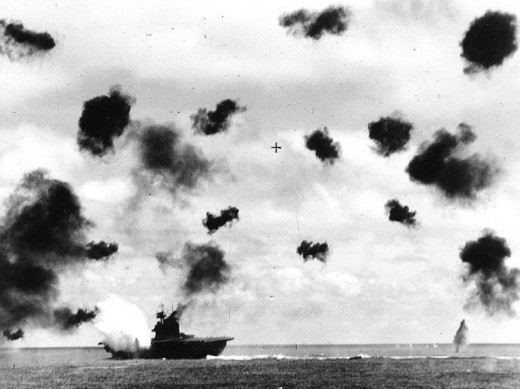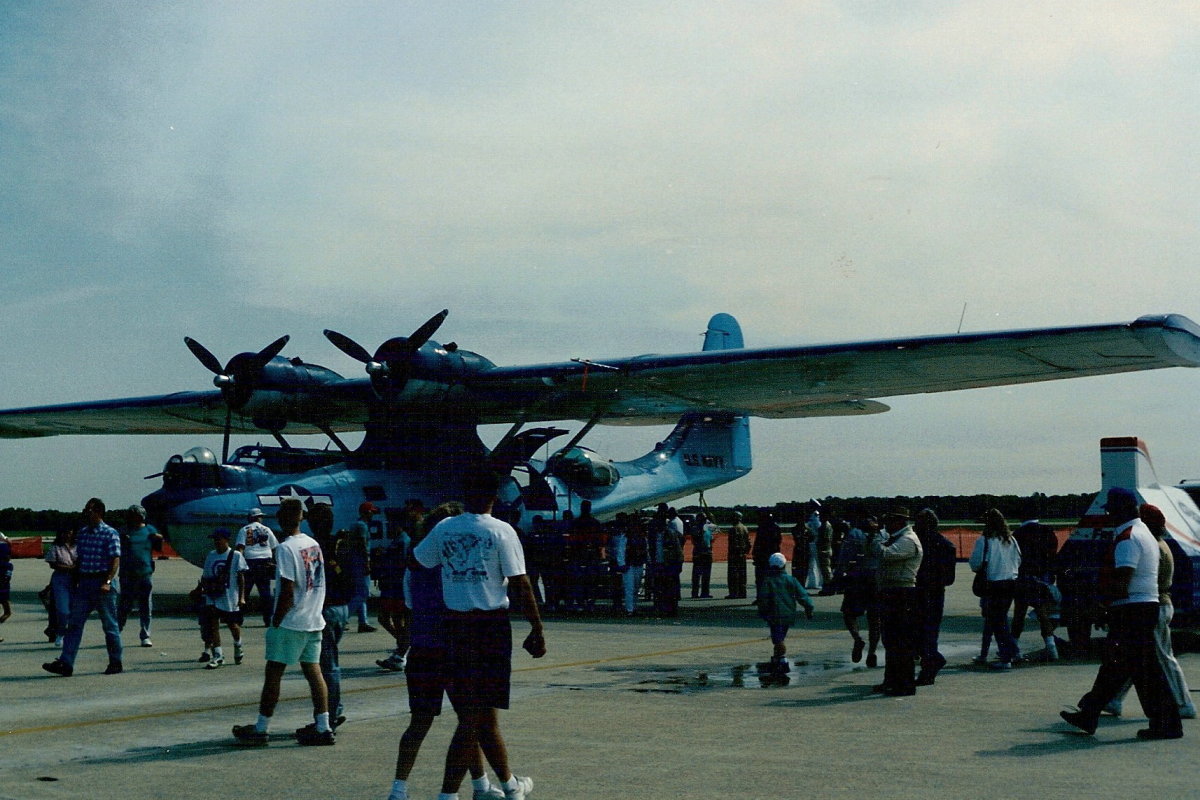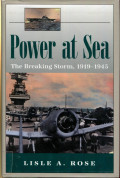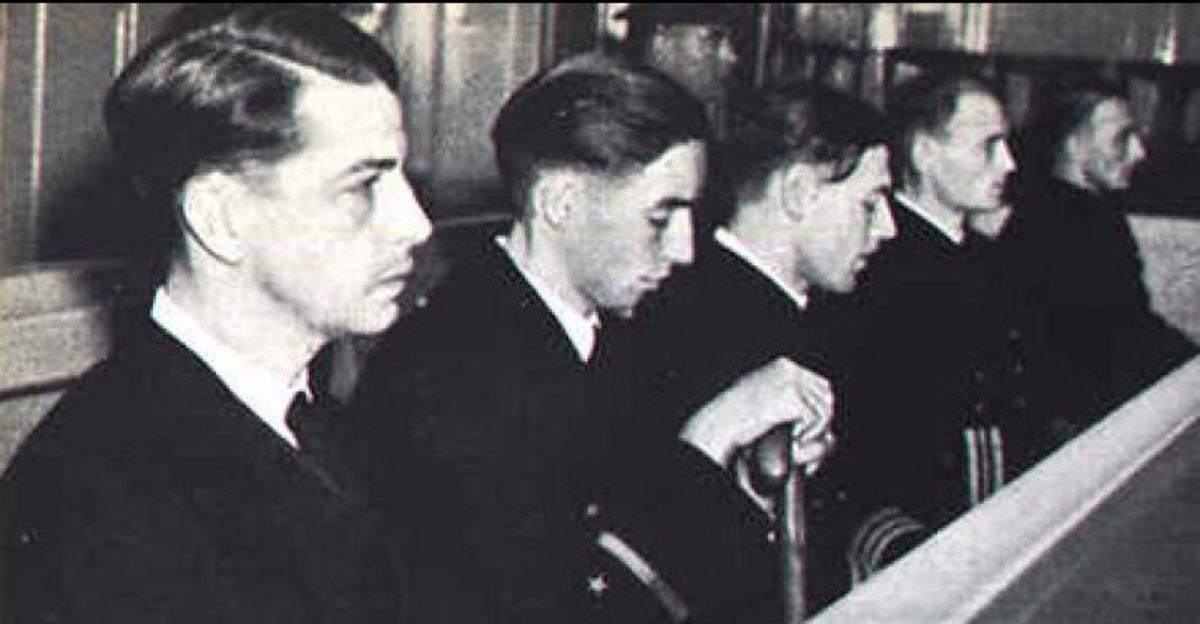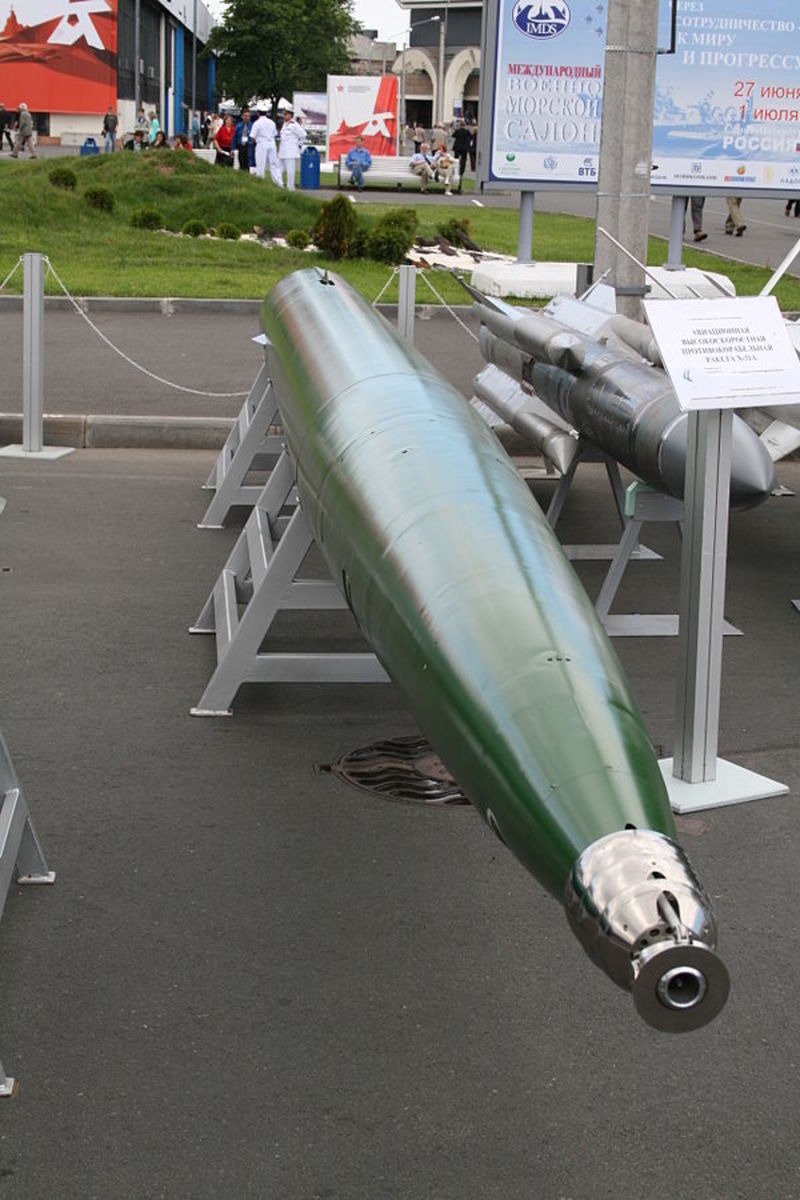- HubPages»
- Education and Science»
- History & Archaeology»
- Military History
The Battle of Midway - The Turning Point of the War in the Pacific
![By US Navy [Public domain] By US Navy [Public domain]](https://usercontent2.hubstatic.com/8446115_f520.jpg)
Setting the Stage for Battle
Prior to the battle of Midway, the Japanese Imperial Navy enjoyed powerful advantages over the American Navy in World War II's Pacific theater. As a result of the surprise attack on Pearl Harbor which drew the United States into World War II on December 7th, 1941, the American Navy was seriously weakened by the time the two forces faced off on a grand scale at Midway in early June of 1942. Though all of the American aircraft carriers were out to sea at the time of the attack on Pearl Harbor, the Japanese strike virtually destroyed the American fleet of battleships stationed there, decimating American military power in the Pacific Ocean in the opening act of the United States' involvement in World War II.
By mid-1942, the Japanese military had steamrolled its way through a steady chain of invasions and conducted dozens of attacks - including an attack on the United States mainland in which a Japanese submarine shelled a California oil refinery near Santa Barbara, and another much more serious attack on Darwin, Australia. The Japanese had also moved American forces out of strategically important areas in the pacific like Guam and the Philippines virtually at will.
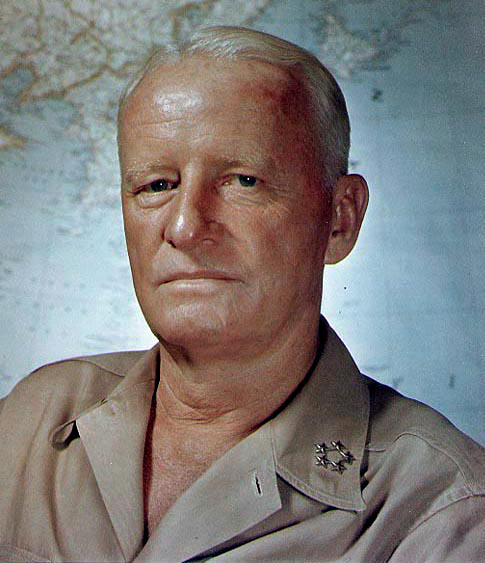
During the months preceding the Japanese Imperial Navy's attempted invasion of Midway, Admiral Chester Nimitz, the Commander in Chief of the American Pacific Fleet (codename CinCPac) began to receive information from ComInt (US Communications Intelligence; responsible for monitoring and decoding intercepted enemy communications) that a large invasion force was being prepared for attack against an unknown target. It seemed logical that such a large attack would be planned for a target of major strategic significance. Midway atoll met this criteria, but so did the militarized island of Oahu in Hawaii, and of course the west coast of the US mainland itself. Additionally, Comint faced credibility issues with the US Navy at the time. Many of the US Navy's higher ups refused to take Comint or its capabilities seriously due to its failure to raise the alarm leading up to the then very recent surprise attack on Pearl Harbor. This created a climate in which Comint was eager to prove itself and its potential value to the Navy.
Mind Games on the Eve of Battle
As intercepted communications continued to trickle in pertaining to the mysterious upcoming invasion, Admiral Nimitz began to share a growing belief within Comint that the location code the Japanese had been using to refer to the invasion's target - AF - referred to Midway. True to his characteristic confidence in Comint's potential, the Commander in Chief of the Pacific Forces approved a plan designed to trick the Japanese into confirming the suspected identity of the mysterious location known to Americans at that point only as "AF."
In mid-May of 1942, the commanding officer of the naval base at Midway sent an unencoded message to the Commandant of his Naval District (Com 14), containing a bogus report that the base at Midway had experienced an unexpected problem with its water supply and needed assistance procuring additional fresh water. Aware of the plan to trick the Japanese, Com 14 responded in a likewise unencoded message that additional water would be provided as soon as possible. On May 16th 1942, the Americans intercepted a Japanese intelligence report which stated that "AF is short on water." With that, the location of the planned invasion had been confirmed, and Admiral Nimitz could begin utilizing all of the other intelligence his Comint staff had intercepted regarding the invasion of "AF" in order to organize his defense of Midway.
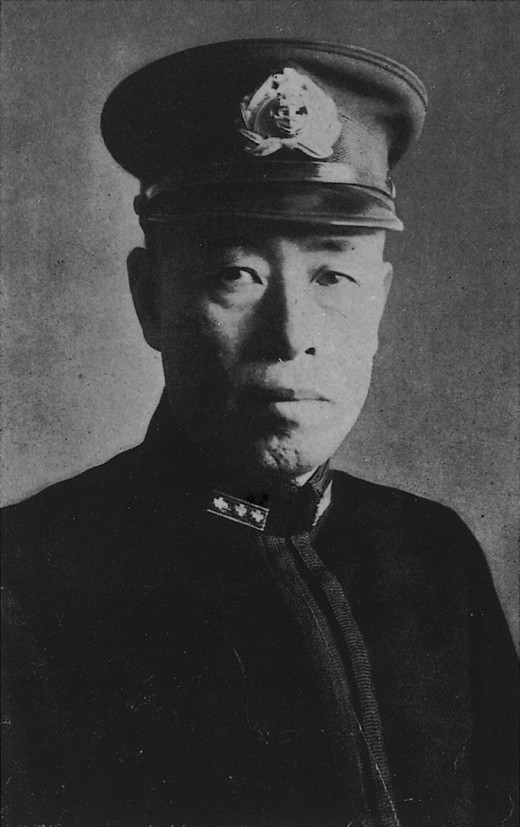
Why Midway?
The attack on Midway made sense on several levels. The invasion and occupation of Midway were actually peripheral goals of the invasion operation. The primary goal was to engage the severely weakened US Navy in a fight it could not retreat from and destroy the US fleet in the Pacific once and for all.
Midway was chosen as the target for this operation by Nimitz' opponent Admiral Isoroku Yamamoto - who had also planned the attack on Pearl Harbor six months earlier. Midway was selected because if attacked at Midway the American Navy in the Pacific could not strategically afford to cede control of the island, and would be forced to make a last stand there, regardless of the strength of the Japanese invasion force. While the Japanese Imperial Navy had a temporarily overwhelming advantage in the number of aircraft carriers and battleships at its disposal, Admiral Yamamoto recognized that the United States' potential for industrial production dwarfed that of Japan, and the war in the Pacific had to be won quickly and decisively if Japan was going to maintain long term control over its recent Pacific conquests.
One Good Trap Deserves Another
Yamamoto's plan was very elaborate and involved sending ships to the Aleutian Islands to stage a diversionary attack there and draw some of the American ships away from Midway. He then planned to launch his real attack on Midway itself, setting a trap for the US Navy involving the submarines and the launching of planes from aircraft carriers. The plan also called for the destruction of American ships a a few at a time as they came to the aid of the besieged naval base rather than fighting the entirety of the US Fleet all at once. In this way Yamamoto planned to minimize the losses to his own fleet while wiping out the American fleet.
What Yamamoto was not aware of, however, was that Admiral Nimitz and his Comint staff had cracked the codes Yamamoto was using to issue orders to his fleet in the months of preparation he needed to set the stage for his ingenious trap. By the time the attack finally came Admiral Nimitz had assembled massive information relevant to Yamamoto's plan, down to the tasks assigned to individual units in Yamamoto's attack force, and by utilizing this information Nimitz was able to set an ambush for Yamamoto by beefing up Midway's defenses, ignoring the diversionary attack in the Aleutians and covertly concentrating his forces nearby Midway to wait in anticipation of the Japanese invasion.
![By Cdr. John Ford, USNR (U.S. Navy "Battle of Midway" movie screenshot) [Public domain] By Cdr. John Ford, USNR (U.S. Navy "Battle of Midway" movie screenshot) [Public domain]](https://usercontent2.hubstatic.com/8446111_f520.jpg)
June 4th, 1942 - Commencement of Battle
At 4:30 in the morning on June 4th, 1942 Admiral Yamamoto, still unaware that he was rushing headlong into a trap, launched his first wave of 108 planes against the US naval base on Midway Island. At the same time, both the US and Japanese fleets launched search planes to scout the area for enemy activity. Unlike the Japanese who did not expect to find American aircraft carriers in the area, the American scouts knew exactly where to look and what they were looking for. At 5:30 am an American seaplane patrolling the likely routes of enemy approach spotted the Japanese fleet and radioed in the location of the Japanese carrier strike force and the first wave of attack planes it had just launched.
At this time the Marine Corps' Fighting Squadron 221 was launched from Midway to intercept and attack the enemy planes en route to Midway, along with 10 torpedo bombers sent after the Japanese ships. When the fighter squadron reached the Japanese formation their technologically inferior Buffalo and Wildcat fighter planes were overwhelmed by Japanese Zeros. The Zeros were faster and sported higher climb speeds and superior maneuverability than the American planes. The marines of Fighting Squadron 221 were all but annihilated as the Japanese air attack continued approaching Midway undeterred. The ten torpedo planes sent to attack the Japanese ships suffered a similar failure, scoring no direct hits against the Japanese ships and losing seven out of their ten planes and pilots.
Fifteen minutes later the first wave of Japanese planes strafed and bombed the recently reinforced defensive positions of the naval base at Midway for 20 long minutes, inflicting heavy damage but falling short of the goals Nimitz preferred to prepare Midway for the planned land invasion. A second wave of fighters and bombers was prepared to finish softening up the island's defenses ahead of the intended amphibious assault.
As the Japanese awaited the return of their first wave of fighter planes and bombers the fleet was attacked five more times by American planes from Midway - starting around 7 am five uncoordinated attacks came from - six Navy TBF-1's, four Army Air Force B-26's, two formations of marine corps bombers, and a formation of Army B-17 bombers. None of these weak and uncoordinated attacks had any effect on the Japanese fleet.
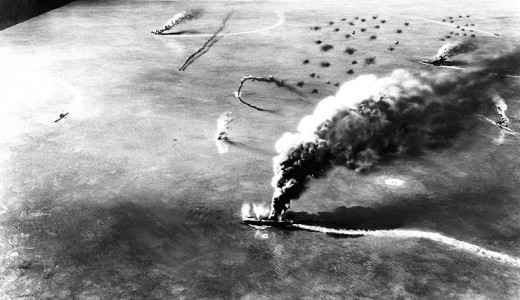
Fierce Fighting and Courageous Sacrifices
Just as Midway's weak and uncoordinated counter-attacks were petering out, the Japanese fleet commander received word that there were more American forces involved in the battle than he had previously known about. They were aircraft carriers and were launching planes heading in the direction of the Japanese carriers.
When this information came in, the Imperial Navy's carriers had already been preparing planes to launch a second attack on Midway and could have launched an attack against the American fleet as soon as word of its presence was received, but rather than do that the Japanese Commander Chuichi Nagumo decided to rearm his planes with torpedoes instead of bombs and recover his planes from the first wave attack against Midway so that his force would be at full strength when it engaged the American fleet.
During the time it took for the American planes from the carriers Enterprise and Hornet to reach the Japanese position the Japanese carriers were able to relocate, and the American torpedo planes, fighters and bombers had nothing to target. These two American aircraft carriers had been commissioned rather recently and their crews did not have a lot of experience in carrier tactics yet. As a result, they had launched their planes out of order, launching their fastest planes, the fighters, first, then their torpedo planes and then their slowest planes, the bombers; rather than launching their planes in reverse order and letting the faster fighter planes catch up with the bombers en route to the target. The result was that the fighter planes from the Hornet and Enterprise spent a lot of time circling around in the air above the ship as the other planes were launched, which had eaten up a significant portion of their fuel.
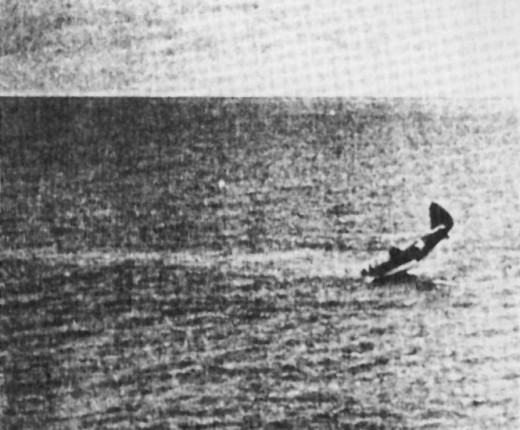
When the planes from the Enterprise and Hornet arrived at the assumed location of the Japanese carriers and did not find the carriers, the squadron leaders made individual decisions to try to scout around and find the Japanese ships. The planes began running out of fuel one by one, starting with the fighters. The crews of many of these planes had to ditch in the ocean when their planes ran out of fuel in their search for the enemy. Even though they knew this was costing their own planes in fuel and that they were in many cases pushing their planes past the point of no return - the importance of this battle had been made clear to the squadron leaders by higher ups on the way to Midway.
Lieutenant-Commander John Waldron was the Squadron Commander of Torpedo Squadron 8 on board the USS Hornet. He had been skeptical of the attack route he had been given, and led his planes in a different direction, apart from the rest of the attack group. When he successfully located the Japanese fleet his problem was different - his planes had fuel but no fighter escort, and arrived ahead of the rest of the attack force.
As they approached the enemy, Waldron issued a final message to his squadron:
“We have truly done the best humanly possible. I actually believe that under these conditions, we are the best in the world. My greatest hope is that we encounter a favorable tactical situation but if we don’t, and the worst comes to the worst, I want each of us to do his utmost to destroy our enemies. If there is only one plane left to make a final run-in, I want that man to go in and get a hit. May God be with us all.”
Waldron - along with every other man in his squadron except one - was killed during the attack when the carriers' escort ships opened up with anti-aircraft fire and over 50 zeros swarmed the squadron of 15 torpedo planes.
Two more squadrons of US torpedo planes met similar fates when they finally found the Japanese fleet after most of their fighter escorts had gone down without ever reaching the battle. The torpedo planes did not hit any ships with their torpedoes, but they did serve the purpose of disorganizing and delaying the preparations taking place aboard the Japanese carriers for what would likely be a decisive attack on the outnumbered and outgunned American carriers.
The Tide Turns
The third of these squadrons of torpedo planes to arrive was from the most experienced US carrier in the battle, the Yorktown. The Yorktown had been involved in The Battle of the Coral Sea a month earlier, and was the oldest of the American aircraft carriers at Midway. The Yorktown's experienced crew had launched its planes in the correct order, beginning with the slowest planes, the bombers, then the torpedo planes, and then the fighters. All planes flew directly towards the target immediately upon takeoff, and the speeds with which the various types of planes flew brought them into a coordinated assault as they approached the target.
So the third squadron of torpedo planes to attack the Japanese fleet, having taken off from the USS Yorktown, did have escort fighters with them when they attacked, however the superior numbers of Japanese Zeros (with superior speed and maneuverability to boot) in the vicinity of the the Imperial Navy's carriers was more than enough to overwhelm both the F4F-4 fighters and the Torpedo Squadron with whom they attacked.
The Yorktown's bomber squadron, flying at high altitude arrived in a coordinated effort with the ship's doomed torpedo and fighter squadrons, and went unnoticed by the Japanese Zeros which were still engaged with the torpedo squadron at a much lower altitude when the bombers arrived. In an incredible stroke of luck, three squadrons of SBD-3 Dauntless bombers, and a squadron each of lost Scouts and Bombers from the Enterprise arrived simultaneously with the Yorktown's bomber squadron. All arrived at high altitude and escaped notice of the Japanese Zeros and the Japanese carriers which were busy turning into the wind to launch their own freshly refueled and torpedo equipped planes against the American carriers.
The American bomber squadrons got to work immediately, dive bombing the vulnerable and distracted Japanese aircraft carriers Akagi, Soryu and Kaga. The bombs from these six squadrons hit home on the decks of all three ships - decks covered with planes stuffed full of fuel and torpedoes. The strikes were decisive and all three carriers would go down that day as a result of this attack. This single attack, the result of tremendous luck and tremendous sacrifice, cut the Japanese Imperial Navy's fleet of aircraft carriers in half - and only one carrier - the Hiryu - remained in the vicinity of Midway.
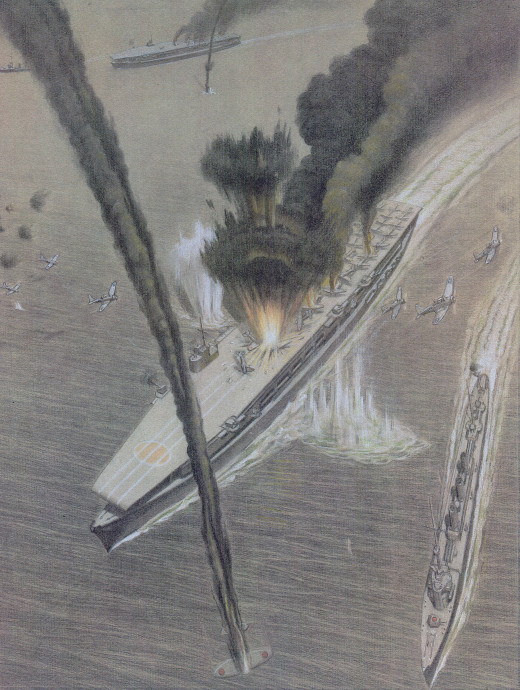
A Last Gasp
Unlike its three doomed sister ships, the Hiryu was able to launch a successful wave of attackers towards the American fleet. Since the American carriers Enterprise and Hornet were relatively close together the American carrier in the most isolated position at the time - the Yorktown was targeted by this group of 18 dive bombers, which hit the Yorktown with three bombs - one of which took out the Yorktown's boilers and stopped the ship.
Two and a half hours later the Hiryu was able to launch yet another attack of ten torpedo planes against the Yorktown, which also found their target with two torpedoes, opening up a massive hole on the Yorktown's port side. Soon after the the Yorktown began to list badly to her damaged side, and the ship was ordered abandoned.
As the Hiryu was attempting to launch its last nine planes it was located by planes from the Enterprise (some of which had been rehomed from the Yorktown), and was hit by at least four bombs, damaging the ship badly enough that the Japanese Captain gave the order to abandon ship.
The battle did not technically end for two more days, however, when the still floating Yorktown was attacked and finally sunk by Japanese submarines to prevent it from being towed back to port and repaired. With that, on the 7th of June 1942 the battle of Midway had ended, and the Japanese Imperial Navy - which had seemed unstoppable a mere 72 hours earlier - would remain on the defensive for the remainder of World War II.
